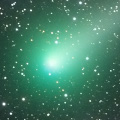
|
Now it is 6.5 mag (Oct. 13, Marco Goiato). It was expected to brighten up to 4-5 mag from autumn to winter. However, the brightness evolution has stopped in September. Now it is not observable. In the Northern Hemisphere, it will appear in the morning sky in late November, then it will be observable in excellent condition. In the Southern Hemisphere, it is hardly observable after this.
Date(TT) R.A. (2000) Decl. Delta r Elong. m1 Best Time(A, h)
Nov. 14 14 22.47 -19 51.9 1.762 0.824 12 6.1 5:05 (288, -9)
Nov. 21 14 20.78 -16 39.8 1.687 0.829 19 6.0 5:11 (291, 0)
|
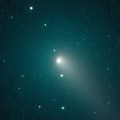
|
It brightened very rapidly. Now it is so bright as 9.3 mag (Nov. 13, Maik Meyer). It is observable at 9-10 mag until next spring in excellent condition in the Northern Hemisphere. It keeps unobservable in the Southern Hemisphere.
Date(TT) R.A. (2000) Decl. Delta r Elong. m1 Best Time(A, h)
Nov. 14 16 29.49 70 31.7 1.886 2.123 89 9.4 18:22 (156, 36)
Nov. 21 16 34.63 68 6.4 1.896 2.112 88 9.4 18:19 (153, 33)
|
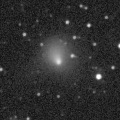
|
Now it is so bright as 10.4 mag (Nov. 7, Juan Jose Gonzalez). It will pass close to the earth from spring to summer in 2016, and it is expected to be observable at 6-7 mag in good condition. It is observable in excellent condition in the Northern Hemispehre. It locates very low in the Southern Hemisphere.
Date(TT) R.A. (2000) Decl. Delta r Elong. m1 Best Time(A, h)
Nov. 14 3 14.04 44 57.0 1.640 2.561 153 10.7 23:38 (180, 80)
Nov. 21 2 35.39 43 15.5 1.569 2.487 152 10.4 22:32 (180, 82)
|
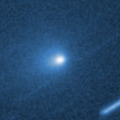
|
Now it is very bright as 10.0 mag (Nov. 7, Marco Goiato). It is observable in the evening low sky until early December in the Southern Hemisphere, or until late December in the Northern Hemisphere.
Date(TT) R.A. (2000) Decl. Delta r Elong. m1 Best Time(A, h)
Nov. 14 18 8.38 -23 8.9 2.180 1.571 40 11.1 18:22 ( 51, 11)
Nov. 21 18 31.84 -23 13.1 2.220 1.582 39 11.2 18:19 ( 51, 11)
|
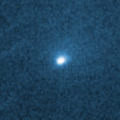
|
It brightened very rapidly. Now it is very bright as 11.1 mag (Nov. 7, Marco Goiato). It keeps 11-13 mag until February. But it keeps very low in the Northern Hemisphere. It will be getting lower gradually after this even in the Southern Hemisphere.
Date(TT) R.A. (2000) Decl. Delta r Elong. m1 Best Time(A, h)
Nov. 14 18 47.28 -25 26.2 1.841 1.418 49 11.2 18:22 ( 43, 15)
Nov. 21 19 12.90 -25 34.3 1.869 1.419 48 11.3 18:19 ( 42, 15)
|

|
It tends to brighten very rapidly around the perihelion passage. It will brighten up to 11 mag from November to December. It will appear in the evening sky in early December, then it will fade out very rapidly.
Date(TT) R.A. (2000) Decl. Delta r Elong. m1 Best Time(A, h)
Nov. 14 16 0.02 -19 22.7 1.511 0.570 10 12.5 18:22 ( 73, -9)
Nov. 21 16 48.35 -20 14.4 1.397 0.515 15 11.6 18:19 ( 69, -5)
|

|
It brightened up to 3.7 mag and became a naked eye comet in mid January in 2015 (Jan. 13, Marek Biely). Now it is fading. But it is bright as 10.7 mag still now (Nov. 7, Neil Norman). In the Northern Hemisphere, it keeps observable for a long time until the comet fades out, although it becomes low temporarily in December. It is not observable until March in the Southern Hemisphere.
Date(TT) R.A. (2000) Decl. Delta r Elong. m1 Best Time(A, h)
Nov. 14 17 3.51 24 12.3 4.469 3.906 49 12.5 18:22 (102, 27)
Nov. 21 17 10.87 23 14.3 4.569 3.976 47 12.6 18:19 (103, 23)
|
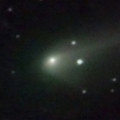
|
Now it is 13.3 mag (Nov. 12, Sandor Szabo). It will be fading slowly after this. In the Northern Hemisphere, it keeps observable in good condition. It will be getting higher gradually after this also in the Southern Hemisphere.
Date(TT) R.A. (2000) Decl. Delta r Elong. m1 Best Time(A, h)
Nov. 14 11 15.24 11 49.2 1.789 1.658 66 12.8 5:05 (293, 47)
Nov. 21 11 28.06 10 47.8 1.775 1.708 69 13.0 5:11 (299, 50)
|
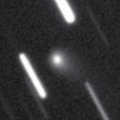
|
Now it is bright as 11.2 mag (Nov. 7, Juan Jose Gonzalez). It keeps 13 mag for a long time from 2015 autumn to 2016 summer. In the Northern Hemispehre, it keeps observable in good condition for a long time. It keeps unobservable in the Southern Hemisphere.
Date(TT) R.A. (2000) Decl. Delta r Elong. m1 Best Time(A, h)
Nov. 14 10 8.89 83 5.5 2.503 2.938 106 13.4 5:05 (184, 41)
Nov. 21 12 17.87 85 16.1 2.466 2.909 106 13.3 5:11 (184, 38)
|

|
First return of a periodic comet which brightened up to 8 mag in major outburst in 2010. It will be observable in excellent condition from winter to spring. Now it is not detected, fainter than 20 mag (Oct. 2, Jean-Francois Soulier).
Date(TT) R.A. (2000) Decl. Delta r Elong. m1 Best Time(A, h)
Nov. 14 9 10.54 29 11.9 1.406 1.849 99 14.1 5:05 (306, 81)
Nov. 21 9 25.10 28 44.3 1.316 1.817 103 13.6 5:11 (331, 83)
|

|
It brightened up to 13 mag in outburst on Nov. 13 (Rob Kaufman). It will be unobservable soon.
Date(TT) R.A. (2000) Decl. Delta r Elong. m1 Best Time(A, h)
Nov. 14 17 56.23 -28 31.5 6.734 5.990 38 14.0 18:22 ( 49, 5)
Nov. 21 18 1.96 -28 25.5 6.796 5.988 32 14.0 18:19 ( 52, 2)
|
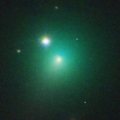
|
It brightened up to 8.8 mag in 2015 spring (Apr. 3, Marco Goiato). Now it is fading. It has already faded down to 13.5 mag (Nov. 11, Mike Wolle). It keeps observable until March when the comet becomes fainter than 18 mag.
Date(TT) R.A. (2000) Decl. Delta r Elong. m1 Best Time(A, h)
Nov. 14 1 58.69 9 48.0 1.565 2.517 159 14.2 22:25 ( 0, 65)
Nov. 21 1 53.56 9 35.9 1.649 2.561 151 14.5 21:53 ( 0, 65)
|
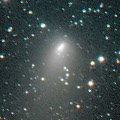
|
It brightened rapidly up to 10.4 mag from July to August (July 18, Maik Meyer). Now it is fading. It has already faded down to 14.2 mag (Nov. 11, Sandor Szabo). It is observable in good condition in the Northern Hemisphere. It is not observable in the Southern Hemisphere.
Date(TT) R.A. (2000) Decl. Delta r Elong. m1 Best Time(A, h)
Nov. 14 20 19.74 46 28.9 1.739 2.059 93 14.3 18:22 (130, 69)
Nov. 21 20 37.85 46 35.5 1.807 2.113 93 14.6 18:19 (129, 68)
|

|
Appearing in the morning sky in the Northern Hemisphere. It will be observable after December in the Southern Hemisphere. It is expected to brighten up to 13 mag from winter to spring. It will be observable in excellent condition in the Southern Hemisphere. But it locates somewhat low in the Northern Hemisphere.
Date(TT) R.A. (2000) Decl. Delta r Elong. m1 Best Time(A, h)
Nov. 14 12 40.64 -2 59.0 2.882 2.226 40 14.5 5:05 (290, 21)
Nov. 21 12 53.95 -4 28.6 2.819 2.217 43 14.4 5:11 (295, 24)
|
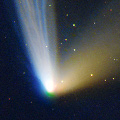
|
It approached to the sun down to 0.3 a.u. on July 6, and brighted up to 3.9 mag (July 6, Thomas Lehmann). Now it is fading. It has already faded down to 12.9 mag (Oct. 3, Chris Wyatt). In the Northern Hemisphere, it keeps observable until the comet fades out. It will not be observable after this in the Northern Hemisphere.
Date(TT) R.A. (2000) Decl. Delta r Elong. m1 Best Time(A, h)
Nov. 14 16 19.03 -53 35.0 3.263 2.552 37 14.4 18:22 ( 40,-24)
Nov. 21 16 37.60 -54 12.8 3.386 2.651 35 14.7 18:19 ( 40,-25)
|

|
Now it is 14.2 mag (Oct. 15, Taras Prystavski). Distant object, but it keeps observable at 14-15 mag for a long time from 2015 to 2016.
Date(TT) R.A. (2000) Decl. Delta r Elong. m1 Best Time(A, h)
Nov. 14 21 20.55 -7 41.7 5.003 5.083 89 14.6 18:22 ( 12, 47)
Nov. 21 21 24.32 -7 48.7 5.096 5.070 82 14.6 18:19 ( 19, 45)
|
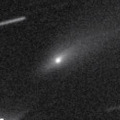
|
Now it is 13.6 mag (Nov. 12, Sandor Szabo). In the Northern Hemisphere, it keeps observable after this while the comet will be fading. It is not observable in the Southern Hemisphere until January when the comet will fade down to 16 mag.
Date(TT) R.A. (2000) Decl. Delta r Elong. m1 Best Time(A, h)
Nov. 14 12 51.26 21 34.2 2.700 2.246 52 14.8 5:05 (266, 33)
Nov. 21 13 3.60 21 3.9 2.689 2.297 56 15.0 5:11 (269, 37)
|
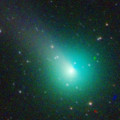
|
It brightened up to 6.0 mag in mid May (May 14, Chris Wyatt). Now it is fading. It has already faded down to 15.6 mag (Nov. 12, Sandor Szabo). In the Northern Hemisphere, it keeps observable in good condition after this while the comet will be fading. It locates somewhat low in the Southern Hemisphere.
Date(TT) R.A. (2000) Decl. Delta r Elong. m1 Best Time(A, h)
Nov. 14 8 1.72 30 14.2 2.301 2.855 114 14.9 4:32 ( 0, 85)
Nov. 21 7 47.99 31 58.6 2.267 2.940 124 15.0 3:51 ( 0, 87)
|
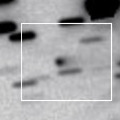
|
Now it is 16.6 mag (Oct. 16, D. Buczynski). It will brighten up to 11 mag from spring to summer in 2016. In the Northern Hemisphere, it keeps observable in good condition while the comet will be brightening. It locates somewhat low in the Southern Hemisphere.
Date(TT) R.A. (2000) Decl. Delta r Elong. m1 Best Time(A, h)
Nov. 14 6 4.05 19 26.5 1.882 2.715 139 15.1 2:35 ( 0, 74)
Nov. 21 6 1.09 19 21.7 1.787 2.674 147 14.9 2:04 ( 0, 74)
|

|
It will be observable at 14 mag from winter to summer. It will be observable in excellent condition in the Southern Hemisphere. It locates low in the Northern Hemisphere.
Date(TT) R.A. (2000) Decl. Delta r Elong. m1 Best Time(A, h)
Nov. 14 12 51.13 -0 28.9 3.041 2.361 39 15.1 5:05 (286, 21)
Nov. 21 13 4.42 -2 20.5 2.968 2.337 42 15.0 5:11 (291, 24)
|
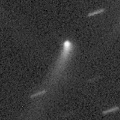
|
Now it is 14.5 mag (Oct. 15, Taras Prystavski). It will be fading slowly after this. In the Northern Hemisphere, it keeps observable for a long time until the comet fades out. In the Southern Hemisphere, it will be low after this.
Date(TT) R.A. (2000) Decl. Delta r Elong. m1 Best Time(A, h)
Nov. 14 0 53.61 15 2.2 3.363 4.221 146 15.2 21:20 ( 0, 70)
Nov. 21 0 43.19 15 0.1 3.454 4.229 136 15.3 20:42 ( 0, 70)
|
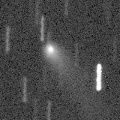
|
Now it is 15.1 mag (Nov. 11, Sandor Szabo). It keeps 15 mag for a long time from 2014 to 2015. It is observable in excellent condition in the Northern Hemisphere. It locates low in the Southern Hemisphere.
Date(TT) R.A. (2000) Decl. Delta r Elong. m1 Best Time(A, h)
Nov. 14 0 54.66 47 6.4 3.627 4.423 139 15.3 21:21 (180, 78)
Nov. 21 0 47.44 47 0.2 3.697 4.452 135 15.3 20:47 (180, 78)
|
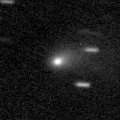
|
First return of a periodic comet discovered in 1994. It brightened up to 13.8 mag from summer to autumn (Sept. 7, Taras Prystavski). Now it is fading, but it is bright as 15.2 mag still now (Nov. 11, Sandor Szabo). It is observable in excellent condition in the Southern Hemisphere. It locates somewhat low in the Northern Hemisphere.
Date(TT) R.A. (2000) Decl. Delta r Elong. m1 Best Time(A, h)
Nov. 14 22 45.63 -22 30.3 2.040 2.457 102 15.4 19:14 ( 0, 33)
Nov. 21 22 51.44 -20 39.9 2.123 2.463 97 15.5 18:52 ( 0, 35)
|
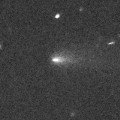
|
Now it is 14.5 mag (Nov. 11, Sandor Szabo). It keeps observable at 15 mag in good condition for a while.
Date(TT) R.A. (2000) Decl. Delta r Elong. m1 Best Time(A, h)
Nov. 14 2 14.24 3 40.9 1.185 2.139 159 15.4 22:41 ( 0, 59)
Nov. 21 2 11.59 3 27.7 1.224 2.148 152 15.5 22:11 ( 0, 59)
|
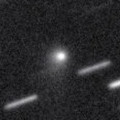
|
Now it is 15.7 mag (Nov. 11, Sandor Szabo). It keeps 15-16 mag for a long time until 2016. It keeps observable in excellent condition in the Northern Hemisphere. It keeps unobservable in the Southern Hemisphere.
Date(TT) R.A. (2000) Decl. Delta r Elong. m1 Best Time(A, h)
Nov. 14 5 10.55 71 5.8 4.572 5.193 124 15.5 1:42 (180, 54)
Nov. 21 4 57.82 72 15.5 4.549 5.196 126 15.4 1:02 (180, 53)
|
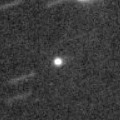
|
Now it is 15.9 mag (Nov. 12, Sandor Szabo). It is expected to brighten rapidly, and to be observable at 14.5 mag in good condition in autumn.
Date(TT) R.A. (2000) Decl. Delta r Elong. m1 Best Time(A, h)
Nov. 14 5 12.86 -8 31.9 0.582 1.486 140 15.5 1:43 ( 0, 46)
Nov. 21 5 13.83 -7 19.2 0.564 1.486 144 15.5 1:17 ( 0, 48)
|

|
Now it is 15.0 mag (Oct. 2, Taras Prystavski). It will be unobservable in early December in the Southern Hemisphere, or in early January in the Northern Hemisphere.
Date(TT) R.A. (2000) Decl. Delta r Elong. m1 Best Time(A, h)
Nov. 14 20 0.56 -14 43.3 4.265 4.005 68 15.8 18:22 ( 34, 33)
Nov. 21 20 8.03 -14 38.2 4.388 4.037 63 15.9 18:19 ( 38, 32)
|

|
It brightened up to 11-12 mag in 2012. It has already faded down to 16.5 mag (July 9, Taras Prystavski). Appearing in the morning sky. It is observable at 16 mag in good condition from winter to spring.
Date(TT) R.A. (2000) Decl. Delta r Elong. m1 Best Time(A, h)
Nov. 14 11 17.48 -6 40.4 10.931 10.452 58 16.3 5:05 (309, 33)
Nov. 21 11 17.59 -6 50.1 10.859 10.490 65 16.3 5:11 (318, 38)
|

|
It brightened up to 13 mag in 2014. Now it is 14.8 mag (Nov. 11, Sandor Szabo). It will be fading slowly after this. It is observable at 16 mag in excellent condition from summer to winter in 2015.
Date(TT) R.A. (2000) Decl. Delta r Elong. m1 Best Time(A, h)
Nov. 14 0 59.75 -0 45.6 3.189 4.014 141 16.4 21:27 ( 0, 54)
Nov. 21 0 57.34 -0 42.8 3.276 4.030 134 16.5 20:57 ( 0, 54)
|

|
Now it is 16.0 mag (Nov. 12, Sandor Szabo). It is observable at 16-17 mag in good condition from October to December in the Northern Hemisphere. It is not observable in the Southern Hemisphere.
Date(TT) R.A. (2000) Decl. Delta r Elong. m1 Best Time(A, h)
Nov. 14 1 26.72 73 46.5 1.472 2.168 122 16.6 21:53 (180, 52)
Nov. 21 1 15.41 67 24.7 1.462 2.202 126 16.6 21:15 (180, 58)
|

|
Now it is 16.7 mag (Nov. 5, Masayuki Suzuki). It was reported as 15.8 mag visually (Nov. 12, Sandor Szabo). It is expected to brighten up to 6 mag in 2017 summer. In the Northern Hemisphere, it keeps observable in good condition until the highlight while the comet will be brightening. In the Southern Hemisphere, it is not observable until early 2017.
Date(TT) R.A. (2000) Decl. Delta r Elong. m1 Best Time(A, h)
Nov. 14 8 19.39 56 49.0 5.895 6.340 112 16.9 4:50 (180, 68)
Nov. 21 8 18.98 57 40.6 5.759 6.282 117 16.8 4:22 (180, 67)
|

|
Now it is 16.7 mag (Oct. 4, Taras Prystavski). It will brighten up to 14 mag in 2016 summer. But it is not observable at the highlight. It keeps observable until March while the comet will be brightening gradually up to 15-16 mag.
Date(TT) R.A. (2000) Decl. Delta r Elong. m1 Best Time(A, h)
Nov. 14 0 15.28 -7 48.4 1.821 2.560 128 16.9 20:42 ( 0, 47)
Nov. 21 0 14.67 -7 47.9 1.867 2.530 121 16.8 20:14 ( 0, 47)
|

|
It brightened up to 6.9 mag in 2014 autumn (Oct. 17, Marco Goiato). Now it is fading. It has already faded down to 15.3 mag (Oct. 3, Taras Prystavski). In the Southern Hemisphere, it keeps observable in good condition until the comet fades out. In the Northern Hemisphere, it keeps observable until winter, but it locates somewhat low.
Date(TT) R.A. (2000) Decl. Delta r Elong. m1 Best Time(A, h)
Nov. 14 22 38.49 -27 49.9 5.293 5.535 99 16.8 19:06 ( 0, 27)
Nov. 21 22 36.39 -27 23.1 5.477 5.600 92 17.0 18:36 ( 0, 28)
|
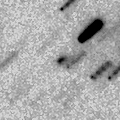
|
Now it is 16.8 mag (Oct. 17, K. Hills). It was reported as 16.0 mag visually (Nov. 12, Sandor Szabo). It is observable at 17 mag in excellent condition in autumn.
Date(TT) R.A. (2000) Decl. Delta r Elong. m1 Best Time(A, h)
Nov. 14 6 22.59 -8 0.0 1.078 1.849 126 17.0 2:53 ( 0, 47)
Nov. 21 6 21.77 -10 15.4 1.068 1.870 130 17.1 2:24 ( 0, 45)
|
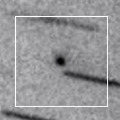
|
First return of a periodic comet discovered in 2003. Now it is 18.1 mag (Oct. 11, J.-F. Soulier). It will approach to the earth from autumn to winter, and it was expected to brighten up to 15 mag and observable in excellent condition. But actually, it is fainter than expected by 1.5 mag.
Date(TT) R.A. (2000) Decl. Delta r Elong. m1 Best Time(A, h)
Nov. 14 4 58.91 -1 44.0 0.755 1.676 147 17.1 1:29 ( 0, 53)
Nov. 21 4 56.61 0 33.3 0.723 1.667 153 17.0 1:00 ( 0, 55)
|
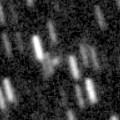
|
Now it is 16.8 mag (Oct. 19, Hidetaka Sato). It keeps 16.5 mag for a long time in 2016, and it will be observable in excellent condition in the Southern Hemisphere. It is hardly observable in the Northern Hemisphere.
Date(TT) R.A. (2000) Decl. Delta r Elong. m1 Best Time(A, h)
Nov. 14 8 50.44 -49 20.9 3.778 3.739 80 17.1 5:05 (358, 6)
Nov. 21 8 42.61 -51 58.3 3.692 3.712 83 17.0 4:45 ( 0, 3)
|
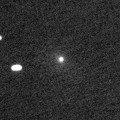
|
Now it is 16.1 mag (Oct. 14, Yasukazu Ikari). It keeps observable in good condition until the comet fades out. In 2014, it must have been observable at 14 mag in good condition in the Southern Hemisphere.
Date(TT) R.A. (2000) Decl. Delta r Elong. m1 Best Time(A, h)
Nov. 14 23 57.06 3 5.7 4.005 4.696 129 17.1 20:24 ( 0, 58)
Nov. 21 23 55.94 3 19.1 4.148 4.748 122 17.2 19:56 ( 0, 58)
|
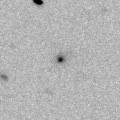
|
Now it is 16.9 mag (Oct. 10, Taras Prystavski). It will be fading after this. It will be fainter than 18 mag at the end of 2015.
Date(TT) R.A. (2000) Decl. Delta r Elong. m1 Best Time(A, h)
Nov. 14 23 33.59 -7 59.4 1.851 2.492 119 17.1 20:01 ( 0, 47)
Nov. 21 23 37.80 -7 30.0 1.933 2.500 113 17.3 19:38 ( 0, 48)
|
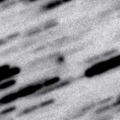
|
It brightened up to 16.4 mag in 2014 (Nov. 14, J. F. Hernandez). Now it is 17.0 mag (Oct. 20, Purple Mountain Observatory). It keeps observable in good condition for a while. But it will be fainter than 18 mag in January.
Date(TT) R.A. (2000) Decl. Delta r Elong. m1 Best Time(A, h)
Nov. 14 4 5.67 27 38.6 1.753 2.720 164 17.2 0:37 ( 0, 83)
Nov. 21 3 59.22 27 11.4 1.767 2.749 171 17.2 0:03 ( 0, 82)
|

|
It will brighten rapidly after this, and it will be observable at 14-15 mag in good condition from winter to summer.
Date(TT) R.A. (2000) Decl. Delta r Elong. m1 Best Time(A, h)
Nov. 14 12 13.45 11 54.3 3.078 2.618 53 17.3 5:05 (281, 36)
Nov. 21 12 23.30 10 33.9 2.986 2.599 57 17.2 5:11 (287, 40)
|
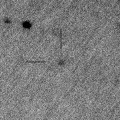
|
Now it is 18.3 mag (Nov. 2, Katsumi Yoshimoto). Now it is near the aphelion. It is observable at 17 mag in good condition from autumn to winter.
Date(TT) R.A. (2000) Decl. Delta r Elong. m1 Best Time(A, h)
Nov. 14 3 33.96 15 43.6 3.298 4.285 174 17.2 0:05 ( 0, 71)
Nov. 21 3 29.28 15 33.3 3.292 4.276 174 17.2 23:28 ( 0, 71)
|
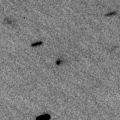
|
It will brighten up to 14 mag in 2017. In 2016, it keeps observable at 16 mag in good condition from winter to spring.
Date(TT) R.A. (2000) Decl. Delta r Elong. m1 Best Time(A, h)
Nov. 14 11 36.05 11 46.5 4.499 4.122 61 17.4 5:05 (288, 43)
Nov. 21 11 41.61 11 22.4 4.388 4.107 67 17.4 5:11 (295, 48)
|
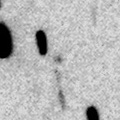
|
First return of a periodic comet discovered in 1998. Now it is 17.9 mag (Oct. 3, J. V. Scotti). It will be observable at 17.5 mag from autumn to winter.
Date(TT) R.A. (2000) Decl. Delta r Elong. m1 Best Time(A, h)
Nov. 14 21 31.44 -10 14.5 1.635 1.923 90 17.4 18:22 ( 8, 45)
Nov. 21 21 41.49 -8 26.6 1.694 1.911 86 17.4 18:19 ( 13, 46)
|
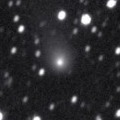
|
Now it is 16.5 mag (Oct. 4, Taras Prystavski). It is fading, but it is a bit brighter than this ephemeris. The fragments B and C are already fainter than 20 mag (June 12, Takaaki Oribe).
Date(TT) R.A. (2000) Decl. Delta r Elong. m1 Best Time(A, h)
Nov. 14 22 34.78 -3 50.1 6.444 6.811 107 17.5 19:02 ( 0, 51)
Nov. 21 22 33.91 -4 22.9 6.611 6.857 100 17.6 18:34 ( 0, 51)
|
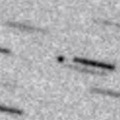
|
Now it is 17.1 mag (Oct. 22, C. Bell). It is observable in good condition in the Northern Hemisphere. It is not observable in the Southern Hemisphere.
Date(TT) R.A. (2000) Decl. Delta r Elong. m1 Best Time(A, h)
Nov. 14 10 50.37 41 9.2 1.657 1.855 85 17.5 5:05 (247, 63)
Nov. 21 11 2.79 41 40.1 1.643 1.906 89 17.5 5:11 (245, 67)
|
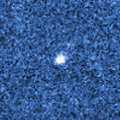
|
Now it is 18.1 mag (Oct. 15, A. Maury, J.-F. Soulier, J.-G. Bosch, T. Noel). It will brighten up to 16 mag in 2016 summer. In the Southern Hemisphere, it keeps observable in good condition for a long time. In the Northern Hemisphere, it is observable only until next March.
Date(TT) R.A. (2000) Decl. Delta r Elong. m1 Best Time(A, h)
Nov. 14 5 34.08 -7 47.1 2.497 3.290 136 17.7 2:05 ( 0, 47)
Nov. 21 5 25.77 -10 33.5 2.415 3.240 140 17.5 1:29 ( 0, 45)
|
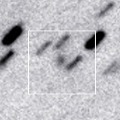
|
Now it is 17.3 mag (Oct. 21, A. Maury, J.-F. Soulier, J.-G. Bosch, T. Noel). It keeps 17.5 mag for a long time from 2016 to 2019. It keeps locating near by the equator.
Date(TT) R.A. (2000) Decl. Delta r Elong. m1 Best Time(A, h)
Nov. 14 8 16.14 -0 40.9 9.965 10.244 103 17.6 4:46 ( 0, 54)
Nov. 21 8 16.24 -0 48.2 9.848 10.231 110 17.6 4:19 ( 0, 54)
|

|
Now it is 18.6 mag (Oct. 11, Hidetaka Sato). It is observable at 17 mag in good condition in winter.
Date(TT) R.A. (2000) Decl. Delta r Elong. m1 Best Time(A, h)
Nov. 14 8 12.47 12 12.0 1.897 2.400 108 17.7 4:42 ( 0, 67)
Nov. 21 8 17.22 12 28.9 1.809 2.391 114 17.6 4:20 ( 0, 67)
|
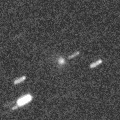
|
Now it is 17.3 mag (Oct. 10, Taras Prystavski). It was expected to be observable at 16 mag in good condition from summer to winter. But actually, it is fainter than originally predicted, and it will be 17.5 mag at best.
Date(TT) R.A. (2000) Decl. Delta r Elong. m1 Best Time(A, h)
Nov. 14 22 34.87 -3 26.6 1.536 2.067 107 17.6 19:03 ( 0, 52)
Nov. 21 22 39.26 -2 0.3 1.591 2.045 102 17.6 18:40 ( 0, 53)
|
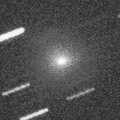
|
It brightened rapidly in mid August, and brightened up to 10.8 mag (Sept. 13, Sandor Szabo). Secondary component H also brightened up to 14.8 mag (Sept. 13, Thomas Lehmann). Now it is fading very rapidly. It has already faded down to 16.5 mag (Oct. 15, Taras Prystavski). In the Northern Hemisphere, it keeps observable in good condition in the morning sky. In the Southern Hemisphere, it keeps locating extremely low from summer to autumn.
Date(TT) R.A. (2000) Decl. Delta r Elong. m1 Best Time(A, h)
Nov. 14 11 4.05 -5 22.9 1.618 1.453 62 17.6 5:05 (312, 37)
Nov. 21 11 13.36 -7 13.9 1.628 1.530 66 18.1 5:11 (319, 39)
|

|
Now it is 16.5 mag (Sept. 8, Jean-Francois Soulier). It has brightened in outburst up to 14 mag twice, in 2006 January and 2011 May. It is around the perihelion now. It keeps observable at 17 mag for a long time after this.
Date(TT) R.A. (2000) Decl. Delta r Elong. m1 Best Time(A, h)
Nov. 14 23 3.57 -6 2.9 5.434 5.900 113 17.6 19:31 ( 0, 49)
Nov. 21 23 4.37 -6 0.9 5.545 5.906 106 17.7 19:04 ( 0, 49)
|
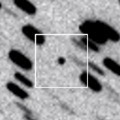
|
Now it is 17.4 mag (Nov. 8, Jean-Francois Soulier). Now it is around the aphelion. It is observable at 17.5 mag in excellent condition in autumn in the Northern Hemisphere. It locates low in the Southern Hemisphere.
Date(TT) R.A. (2000) Decl. Delta r Elong. m1 Best Time(A, h)
Nov. 14 2 19.08 38 37.5 1.456 2.395 156 17.6 22:45 (180, 86)
Nov. 21 2 3.02 36 39.8 1.481 2.400 152 17.7 22:01 (180, 88)
|

|
Now it is 18.3 mag (Oct. 13, Space Surveillance Telescope, Atom Site). It is observable at 16.5 mag in excellent condition from December to February. It locates somewhat low in the Southern Hemisphere.
Date(TT) R.A. (2000) Decl. Delta r Elong. m1 Best Time(A, h)
Nov. 14 8 8.20 17 20.4 1.361 1.944 110 17.9 4:38 ( 0, 72)
Nov. 21 8 16.56 17 16.8 1.293 1.938 115 17.7 4:19 ( 0, 72)
|

|
It will pass the perihelion in 2019. However, it has not been brightening since the discovery in 2010. Now it is 18.0 mag (Oct. 6, Yasukazu Ikari). It keeps observable in excellent condition from autumn to next spring in the Northern Hemisphere. It is not observable in the Southern Hemisphere.
Date(TT) R.A. (2000) Decl. Delta r Elong. m1 Best Time(A, h)
Nov. 14 3 34.16 47 42.2 10.059 10.927 150 17.7 0:05 (180, 77)
Nov. 21 3 30.76 47 48.1 10.022 10.903 151 17.7 23:30 (180, 77)
|
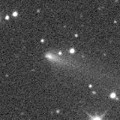
|
Now it is 15.3 mag (Oct. 10, Taras Prystavski). It keeps observable in good condition for a while. But it will be fading after this, and will be fainter than 18 mag in November.
Date(TT) R.A. (2000) Decl. Delta r Elong. m1 Best Time(A, h)
Nov. 14 0 2.54 -0 36.0 1.550 2.308 129 17.9 20:30 ( 0, 54)
Nov. 21 0 5.35 -0 24.4 1.655 2.344 122 18.2 20:05 ( 0, 55)
|
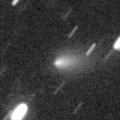
|
It was so faint as 20.0 mag in August (Aug. 17, Hidetaka Sato). However, it brightened by 6 mag in outburst in mid September, and brightened up to 13.7 mag (Sept. 21, Seiichi Yoshida). Now it is fading rapidly. It has already faded down to 16.1 mag (Oct. 19, Taras Prystavski). It keeps observable in excellent condition for a while.
Date(TT) R.A. (2000) Decl. Delta r Elong. m1 Best Time(A, h)
Nov. 14 4 34.92 -0 43.1 1.417 2.341 152 17.9 1:06 ( 0, 54)
Nov. 21 4 28.07 -1 21.8 1.447 2.385 156 18.4 0:31 ( 0, 54)
|
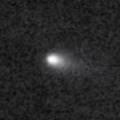
|
It brightened up to 15.9 mag in June as predicted (June 23, Ken-ichi Kadota). It was expected to be observable at 13 mag in good condition from summer to autumn. However, Jean-Gabriel Bosch detected the comet became disintegrating in July. Now it is so faint as 20.1 mag (Oct. 15, Pan-STARRS 1, Haleakala). The fragment D and B are also observed as 19.0 mag (Sept. 20, Michael Jager) and 20.9 mag (Aug. 21, Pan-STARRS 1, Haleakala) respectively.
Date(TT) R.A. (2000) Decl. Delta r Elong. m1 Best Time(A, h)
Nov. 14 2 0.79 4 25.8 0.966 1.918 157 19.8 22:28 ( 0, 60)
Nov. 21 1 58.76 5 1.1 1.026 1.948 150 20.0 21:58 ( 0, 60)
|
|
![]()
 C/2014 Q2 ( Lovejoy )
C/2014 Q2 ( Lovejoy ) 67P/Churyumov-Gerasimenko
67P/Churyumov-Gerasimenko C/2014 W2 ( PanSTARRS )
C/2014 W2 ( PanSTARRS ) P/2010 V1 ( Ikeya-Murakami )
P/2010 V1 ( Ikeya-Murakami ) 29P/Schwassmann-Wachmann 1
29P/Schwassmann-Wachmann 1 88P/Howell
88P/Howell C/2015 F4 ( Jacques )
C/2015 F4 ( Jacques ) 116P/Wild 4
116P/Wild 4 C/2014 Q1 ( PanSTARRS )
C/2014 Q1 ( PanSTARRS ) C/2011 KP36 ( Spacewatch )
C/2011 KP36 ( Spacewatch ) 19P/Borrelly
19P/Borrelly C/2015 G2 ( MASTER )
C/2015 G2 ( MASTER ) 81P/Wild 2
81P/Wild 2 C/2014 Y1 ( PanSTARRS )
C/2014 Y1 ( PanSTARRS ) C/2014 A4 ( SONEAR )
C/2014 A4 ( SONEAR ) C/2014 N3 ( NEOWISE )
C/2014 N3 ( NEOWISE ) 318P/2014 M6 ( McNaught-Hartley )
318P/2014 M6 ( McNaught-Hartley ) 61P/Shajn-Schaldach
61P/Shajn-Schaldach C/2013 V4 ( Catalina )
C/2013 V4 ( Catalina ) 230P/LINEAR
230P/LINEAR C/2012 F3 ( PanSTARRS )
C/2012 F3 ( PanSTARRS ) C/2006 S3 ( LONEOS )
C/2006 S3 ( LONEOS ) 117P/Helin-Roman-Alu 1
117P/Helin-Roman-Alu 1 C/2015 GX ( PanSTARRS )
C/2015 GX ( PanSTARRS ) C/2015 V2 ( Johnson )
C/2015 V2 ( Johnson ) 118P/Shoemaker-Levy 4
118P/Shoemaker-Levy 4 C/2012 K1 ( PanSTARRS )
C/2012 K1 ( PanSTARRS ) P/2015 Q1 ( Scotti )
P/2015 Q1 ( Scotti ) 329P/2015 T1 ( LINEAR-Catalina )
329P/2015 T1 ( LINEAR-Catalina ) C/2015 B2 ( PanSTARRS )
C/2015 B2 ( PanSTARRS ) C/2015 K1 ( MASTER )
C/2015 K1 ( MASTER ) 151P/Helin
151P/Helin 44P/Reinmuth 2
44P/Reinmuth 2 77P/Longmore
77P/Longmore 74P/Smirnova-Chernykh
74P/Smirnova-Chernykh 65P/Gunn
65P/Gunn 328P/2015 S1 ( LONEOS-Tucker )
328P/2015 S1 ( LONEOS-Tucker ) C/2011 J2 ( LINEAR )
C/2011 J2 ( LINEAR ) 162P/Siding Spring
162P/Siding Spring C/2015 T4 ( PanSTARRS )
C/2015 T4 ( PanSTARRS ) C/2014 B1 ( Schwartz )
C/2014 B1 ( Schwartz ) 211P/Hill
211P/Hill 50P/Arend
50P/Arend 141P/Machholz 2
141P/Machholz 2 174P/(60558) 2000 EC98 ( Echeclus )
174P/(60558) 2000 EC98 ( Echeclus ) (3200) Phaethon
(3200) Phaethon 204P/LINEAR-NEAT
204P/LINEAR-NEAT C/2010 U3 ( Boattini )
C/2010 U3 ( Boattini ) 57P/du Toit-Neujmin-Delporte
57P/du Toit-Neujmin-Delporte 205P/Giacobini
205P/Giacobini 51P/Harrington
51P/Harrington![]()

















































